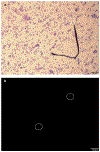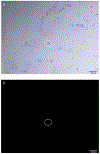Identifying aerosolized cyanobacteria in the human respiratory tract: A proposed mechanism for cyanotoxin-associated diseases
- PMID: 30248825
- PMCID: PMC6159226
- DOI: 10.1016/j.scitotenv.2018.07.226
Identifying aerosolized cyanobacteria in the human respiratory tract: A proposed mechanism for cyanotoxin-associated diseases
Abstract
Cyanobacteria produce harmful toxins that have been associated with several acute conditions and chronic human diseases, like gastroenteritis, non-alcoholic liver disease, and amyotrophic lateral sclerosis. Aerosol from waterbodies appears to be a likely mechanism for exposure. We conducted a study of human biospecimens focused on the cyanobacterial aerosilization process by evaluating the extent to which cyanobacteria can invade the human respiratory tract. Our study suggests that humans routinely inhale aerosolized cyanobacteria, which can be harbored in the nostrils and the lungs. Using PCR, cyanobacteria were found at high frequencies in the upper respiratory tract (92.20%) and central airway (79.31%) of our study subjects. Nasal swabs were not predictive of bronchoalveolar lavage (BAL) when detecting inhaled cyanobacteria. Interestingly, we found no evidence that time of year was a significant factor for cyanobacteria positivity (BAL cytology p = 1.0 and PCR p = 1.0); (nasal swab cytology p = 0.051 and PCR p = 0.65). Additionally, we found that proximity to a waterbody was not a significant factor for cyanobacteria positivity in BAL and nasal swabs collected during cyanobacteria bloom season [May-October] (p = 0.46 and p = 0.38). These data suggest that cyanobacteria exposure may be a prevalent and chronic phenomenon not necessarily restricted to waterbodies alone. Sources of indoor exposure warrant future investigation. Given the widespread prevalence of cyanobacterial exposure in the airway, investigation of the aerosol spread of cyanotoxins, more specifically, is warranted. Our findings are consistent with the hypothesis that aerosol is a significant route for cyanobacteria exposure, and thus a likely route of transmission for cyanotoxin-associated human diseases.
Keywords: Aerosol exposure; Cyanobacteria; Environmental toxin; Human health; Respiration.
Copyright © 2018 Elsevier B.V. All rights reserved.
Figures




Similar articles
-
Health-based cyanotoxin guideline values allow for cyanotoxin-based monitoring and efficient public health response to cyanobacterial blooms.Toxins (Basel). 2015 Feb 5;7(2):457-77. doi: 10.3390/toxins7020457. Toxins (Basel). 2015. PMID: 25664510 Free PMC article.
-
Toxicology of microcystins with reference to cases of human intoxications and epidemiological investigations of exposures to cyanobacteria and cyanotoxins.Arch Toxicol. 2017 Feb;91(2):621-650. doi: 10.1007/s00204-016-1921-6. Epub 2017 Jan 2. Arch Toxicol. 2017. PMID: 28042640 Review.
-
Risk Assessment Workgroup report.Adv Exp Med Biol. 2008;619:759-829. doi: 10.1007/978-0-387-75865-7_35. Adv Exp Med Biol. 2008. PMID: 18461791
-
Toxic Cyanobacteria: A Growing Threat to Water and Air Quality.Environ Sci Technol. 2021 Jan 5;55(1):44-64. doi: 10.1021/acs.est.0c06653. Epub 2020 Dec 18. Environ Sci Technol. 2021. PMID: 33334098 Review.
-
Quantitative assessment of aerosolized cyanobacterial toxins at two New Zealand lakes.J Environ Monit. 2011 Jun;13(6):1617-24. doi: 10.1039/c1em10102a. Epub 2011 Apr 14. J Environ Monit. 2011. PMID: 21491044
Cited by
-
Airborne microalgal and cyanobacterial diversity and composition during rain events in the southern Baltic Sea region.Sci Rep. 2022 Feb 7;12(1):2029. doi: 10.1038/s41598-022-06107-9. Sci Rep. 2022. PMID: 35132131 Free PMC article.
-
Harmful algal bloom aerosols and human health.EBioMedicine. 2023 Jul;93:104604. doi: 10.1016/j.ebiom.2023.104604. Epub 2023 May 8. EBioMedicine. 2023. PMID: 37164781 Free PMC article. Review.
-
Lesser-Known Cyanotoxins: A Comprehensive Review of Their Health and Environmental Impacts.Toxins (Basel). 2024 Dec 19;16(12):551. doi: 10.3390/toxins16120551. Toxins (Basel). 2024. PMID: 39728809 Free PMC article. Review.
-
The first characterization of airborne cyanobacteria and microalgae in the Adriatic Sea region.PLoS One. 2020 Sep 10;15(9):e0238808. doi: 10.1371/journal.pone.0238808. eCollection 2020. PLoS One. 2020. PMID: 32913356 Free PMC article.
-
Lipopolysaccharide from the Cyanobacterium Geitlerinema sp. Induces Neutrophil Infiltration and Lung Inflammation.Toxins (Basel). 2022 Apr 9;14(4):267. doi: 10.3390/toxins14040267. Toxins (Basel). 2022. PMID: 35448876 Free PMC article.
References
-
- Azevedo SM, Carmichael WW, Jochimsen EM, Rinehart KL, Lau S, Shaw GR, et al. 2002. Human intoxication by microcystins during renal dialysis treatment in caruaru-brazil. Toxicology 181-182:441–446. - PubMed
-
- Backer LC, Fleming LE, Rowan A, Cheng Y-S, Benson J, Pierce RH, et al. 2003. Recreational exposure to aerosolized brevetoxins during florida red tide events. Harmful algae 2:19–28.
MeSH terms
Substances
Grants and funding
LinkOut - more resources
Full Text Sources
Other Literature Sources

